


The Middleport Pottery, one of the few remaining, active, potteries in England, was built in 1888 by Burgess & Leigh Ltd and is located in Burslem, Stoke-on-Trent, Staffordshire. A memorable tour of the facility was included in our 2015 England meeting. Nineteenth century methods continue to be employed in the 21st century.
Tiles don't need to be placed on floors, walls, or surrounding a fireplace. This one nicely compliments a chair. The tile pattern shown here is Wheat Bouquet, and for those interested in additional information, it is pattern # 19246 in the TCC Database, of Patterns and Sources. Thanks to Jayne Scott for the images, posted to our website Message Board.
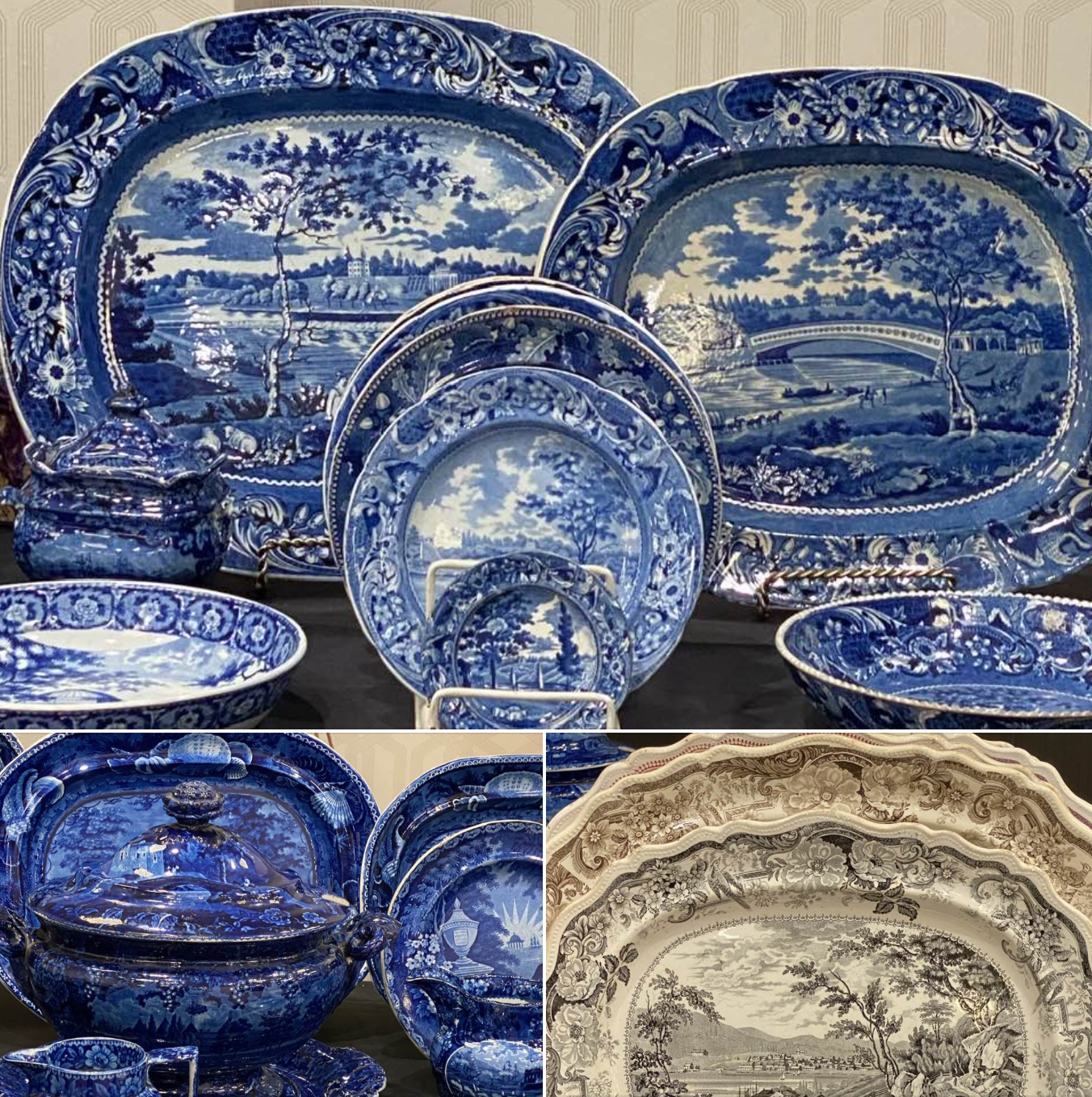 Seven superb lectures, the largest ever raffle, and tours of the Winterthur transferware rooms and reserve collection highlighted the Philadelphia 2024 Annual Meeting. Shown is a smattering of the fantastic transferware presented at the meeting’s final event, the Show and Sale. Photo credit: Judie Siddall
Seven superb lectures, the largest ever raffle, and tours of the Winterthur transferware rooms and reserve collection highlighted the Philadelphia 2024 Annual Meeting. Shown is a smattering of the fantastic transferware presented at the meeting’s final event, the Show and Sale. Photo credit: Judie Siddall
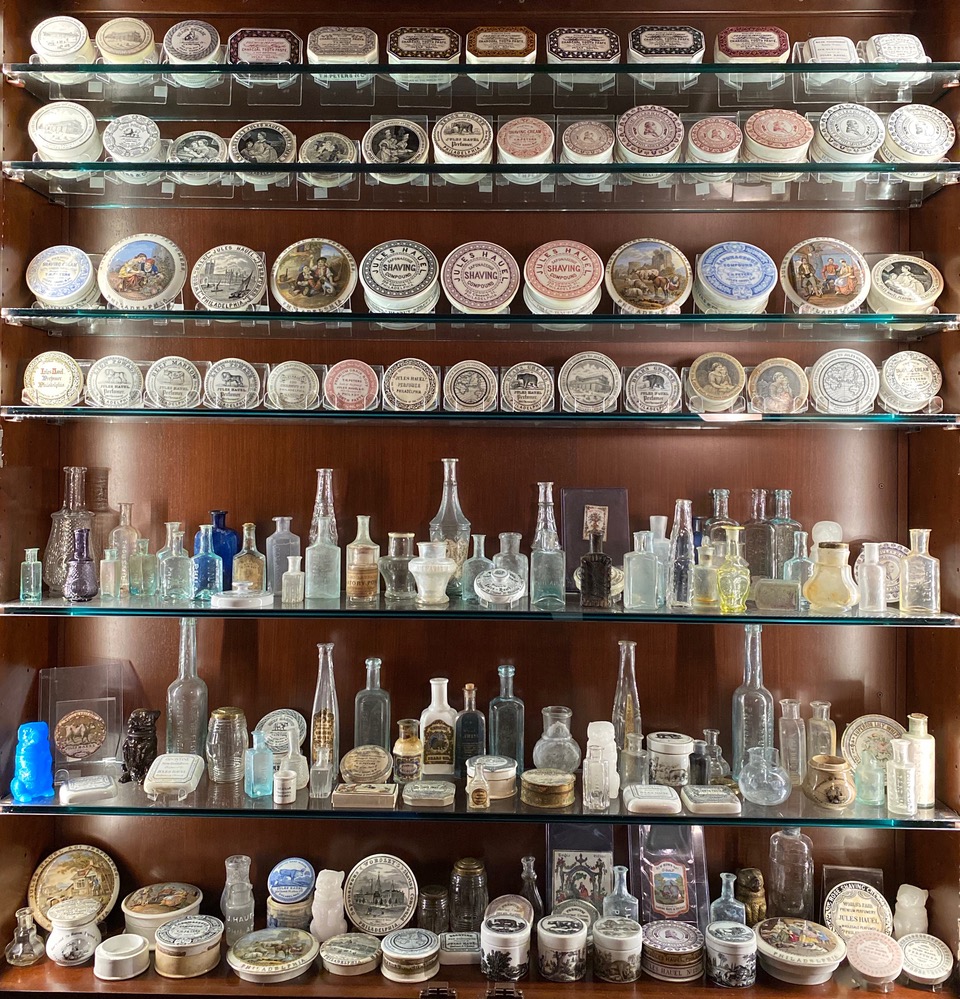 On view, a spectacular collection of Philadelphia producer pot lids and bottles. Jules Hauel was the most prolific of the producers, active 1839-60. This is perhaps the most complete collection of Hauel lids and bottles (the image includes a few samples from other Philadelphia producers). Our April 26-28, 2024 meeting in Philadelphia will include a lecture on the topic of Philadelphia product producers and their transfer-printed product containers and lids.
On view, a spectacular collection of Philadelphia producer pot lids and bottles. Jules Hauel was the most prolific of the producers, active 1839-60. This is perhaps the most complete collection of Hauel lids and bottles (the image includes a few samples from other Philadelphia producers). Our April 26-28, 2024 meeting in Philadelphia will include a lecture on the topic of Philadelphia product producers and their transfer-printed product containers and lids.
Excavation at the Spode Works in Stoke-on-Trent. Just one example of several thousand images related to the pottery industry and transferware available for download from the TCC website Image Gallery: https://www.transferwarecollectorsclub.org/annex/image-gallery/
Just a very small fraction of the spectacular transferware collection assembled by Colin and Patricia Parkes, our hosts for an afternoon during our 2015 England tour. Most if not all of the patterns shown here are in the TCC Database of Patterns and Sources, as Colin was an avid DB editor. We are saddened by Colin’s recent death.
Use it Wisely. Words to the wise from William Pyke, Diamond Merchant and Goldsmith in Birkenhead, England. This merchant plate, a complimentary gift to customers, dates 1891-1905. TCC members can learn how we dated the plate by viewing Entry 15552 in the Database of Patterns and Sources. Also shown is the Pyke Grange Road shop.
Ceramic artist Forrest Middleton, of FLM Ceramics in Petaluma, CA, creates transfer-printed pottery using tissue transfers from silk screened “plates”, applied directly to the thrown or formed pot or tile. For more information, see the FLM website: http://www.flmceramics.com
At least 107 transferware patterns are appended to interior and exterior walls at four locations within Junagarh Fort. Shown here is a projecting window surround, with at least 37 patterns. How many can you identify? Refer to the 2020 article by Hoexter and Siddall, in TCC Bulletin Vol. XXI, No. 3. Members can download the entire bulletin; the article is available to anyone here.
Judge for yourself the quality of the source print, and what was deleted/added to the transferware engraving. The source print is “Ceremony of Washing the Goddess Cali and the Idol Jagan-Nath”, found in Cyclopedia Londiniensis, 1805; the 5.25 inch high by 11.75 inch diameter bowl is by an unknown maker. More information in the TCC Database of Patterns and Sources; this pattern is named “Goddess Kali”, and is DB entry #4793.
Thanks to Rob Hunter’s FB site for this ca. 1765-70 transferware (bat printed?) sepia creamware plate in the Chipstone collection, with an image of Hector being dragged around the walls of Troy behind Achilles’ cart as described in Homer’s Iliad. Thanks to Google Images and the website Alamy for this 1719 public domain image of a print by Bernard Picart, the probable source print, although Chipstone references an engraving by T. Rothwell from a 1711 translation of the Iliad. Whatever the source, the plate is spectacular! Click on image for larger version.
Atkinson’s Bears Grease pot lid, 57 mm (2.24 in) diameter. Bears grease was a popular pomade for men’s hair. The company occupied the 44 Gerrard Street London address between 1818 and 1832, making this lid one of the earliest! The accompanying polar bear figure is 9-½ inches high and 16 inches long, and is extremely uncommon (only a handful known). It would have likely been placed in a shop window. Little doubt Staffordshire, England, although makers, unknown. Photo credits: Bob Houghton (lid), David Hoexter (bear figure).
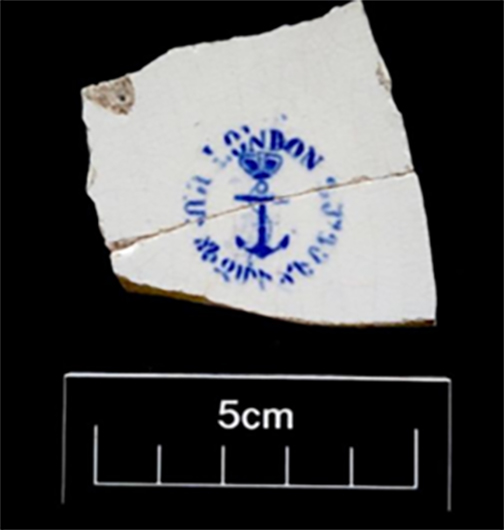 An Australian graduate student has asked for our assistance in identifying this apparent retailers mark, which includes text in (possibly) Cyrillic. Please send your thoughts to the TCC web administrator, webadministrator@transferwarecollectorsclub.org.
An Australian graduate student has asked for our assistance in identifying this apparent retailers mark, which includes text in (possibly) Cyrillic. Please send your thoughts to the TCC web administrator, webadministrator@transferwarecollectorsclub.org.
We often receive requests on the TCC website Message Board for assistance in identifying patterns. We generally can successfully provide the pattern name and related information. But occasionally a request stumps us. Following is the first in what no doubt will be a series of requests for members’ help. This mug, missing its handle, is 5 inches high and wide (diameter). It currently resides in Scotland. The member(s) who successfully provides pattern ID, maker, and anything else of interest wins great fame and bragging rights.
A residence interior wall with various items, enhanced with just one transferware platter. The pattern is “Masonic Institution for Girls, St George’s Field, Southwark”. This example is 11.5 X 14 inches, smaller than the example shown in the TCC Database of Patterns and Sources, where it is record # 3886. The building was constructed in the late 18th c and housed up to 100 orphaned daughters of freemasons through 1856. Although the maker is unknown, a retailers mark on the reverse names John Burn, Newport Market, London, and in cludes the name J.J. Cuff, who operated a tavern and coffee ship on the premises in 1805 and at least through the printing of this platter, probably the 1820s. TCC members can view the DB entry for additional information.
Rich with content for ceramic collectors, researchers, authors, curators, and historic archaeologists, the sites are sure to deliver value for their visitors. The exhibition’s curators continue to enhance them and, now, with site application upgrades, including a new magnification feature and upgraded content management capabilities, the TCC and its collaborators are pleased to relaunch these exhibits, all free to a worldwide audience.
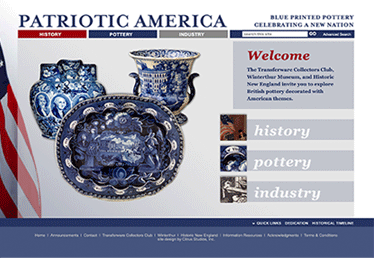
Branded Patriotic America, debuted in 2014 in collaboration with Historic New England, and the Winterthur Museum
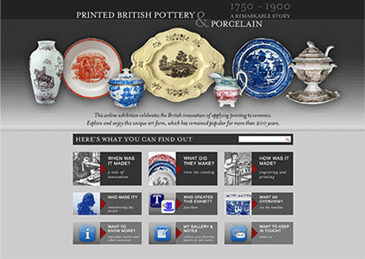
Launched in 2015 in partnership with the Northern Ceramic Society.
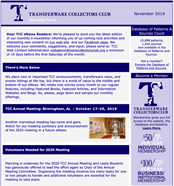 Not a member but want to receive email updates?
Not a member but want to receive email updates?